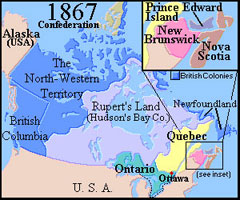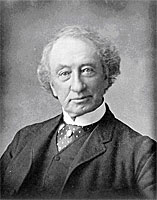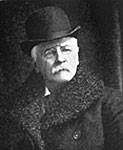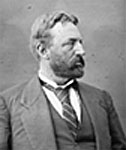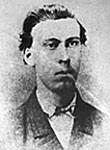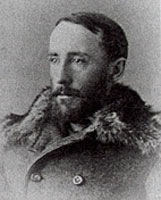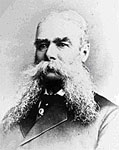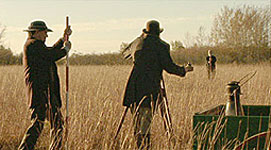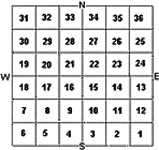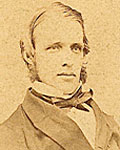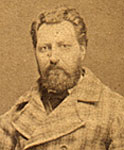ALEXANDER MONTGOMERY MUCKLE (1844-1908) CHAPTER TWO (Last Updated: August 28, 2012)
For more about Alex MUCKLE, his ancestors, his siblings and his activities prior to Confederation, click on this link: THE MUCKLE STORY – CHAPTER ONE
Canadian Confederation 1867
On July 1, 1867 the British colonies in North America were united under the British North American Act to become the Dominion of Canada. Sir John A. MACDONALD was appointed as Canada’s first Prime Minister. William McDOUGALL (1822-1905) became the first Minister of Public Works for the new Dominion of Canada, and he began negotiations to acquire Rupert’s Land from the HBC.
1868
By 1868 Robert Alexander HARRISON (1833-1878), Alex MUCKLE’s brother-in-law, had re-married to Johanna SCOBIE. During that year the HARRISON-MUCKLE family relationship deteriorated to the point where Mrs. MUCKLE was only allowed to visit with her granddaughter Anna on rare occasions. Now, she was essentially banished from the environs of Englefield altogether. Alex MUCKLE had defaulted on a debt he had at the bank (HARRISON had repaid this debt on Alex’s behalf) and had been fired from his job there for misconduct. As a result of that, HARRISON discontinued an allowance he had been paying to Mrs MUCKLE.
Anticipation of a New Province of Manitoba
The year of 1868 was a time of extreme hardship at Red River. The buffalo hunt was a failure; fish and game were scarce; drought and a plague of grasshoppers ravaged the crops. A Relief Committee was formed and generous donations came from Eastern Canada. The Government’s contribution to the needy of Red River was to build a road. This would provide badly needed jobs and income for many destitute labourers. It would also make it easier for an anticipated flood of immigrants to travel to the region.
At that time there was no overland route through Canada to the Northwest except through the USA. Adding to the urgency to establish one was the fact that the Americans were also considering annexation of the western territory. The new road would be called the Dawson Road (after Samuel DAWSON who had built a rough trail along the same route many years before).
Alexander MUCKLE was among the first to learn of these new developments from his guardian brother-in-law Robert HARRISON who was in frequent contact with most of the top Government leaders of the day. There was excitement in the air! Perhaps this was a chance for independence; to become his own man, an opportunity to prove to himself and HARRISON that he could make a life for himself, on his own terms.
John SNOW and the Road Builders
L-R: Charles Mair, John Schultz and Thomas Scott
That summer of 1868, William McDOUGALL sent John Allan SNOW (1824-1888), a Surveyor, to build the Dawson Road. Charles MAIR (1838-1927) was hired as Paymaster for the project.
Upon their arrival at Red River, one of the first people to welcome them with open arms was a prominent businessman named Dr John Christian SCHULTZ (1840-1896). Dr SCHULTZ had arrived there eight years previously. With his half-brother, Henry McKENNEY (1826-1891), he had built the Royal Hotel at what was to become Portage & Main. He operated as a free trader in furs in opposition to the HBC throughout the early 1860's. He opened a drug store on Main Street and practiced medicine (although it is doubtful that he acquired a doctorate, as he claimed). In 1864 SCHULTZ became a partner in the "Nor'Wester", Red River's earliest newspaper, using it as an anti-HBC organ. That same year he was elected Junior Warden and Worshipful Master of the first Masonic Lodge in the Canadian Northwest.
Much less joyful about the arrival of these intruders into their domain were Louis RIEL (1844-1885)and his French-Métis brethren who had not been consulted about the decision to divvy up their land and share it with a flood of immigrants who would disrupt their way of life as buffalo hunters. The buffalo population was already in a serious decline. They were about to be reduced to second-class citizens in their own country.
On Oct 27, 1868, SNOW called on William MacTAVISH (1815-1870), destined to be the last HBC Governor of Rupert’s Land. MacTAVISH assured them that there was not the least objection to work beginning on the road. All SNOW had to do now was to hire a work crew and get started.
One of the men hired by SNOW for his work crew was a young man by the name of Thomas SCOTT (1842-1870) who would soon play a pivotal role in the Red River Rebellion. Interestingly, SCOTT was a native of Clandeboye, Northern Ireland, as was Alex’s mother, Mrs. MONTGOMERY-MUCKLE.
Consequently, SNOW proceeded to set up a headquarters about 30 miles east of the Forks (where Sainte-Anne is today).
MUCKLE arrives at Red River with DENNIS’ Survey Crew
Alexander Montgomery Muckle
On July 10, 1869, William McDOUGALL told John Stoughton DENNIS to consider himself a temporary employee of his department and ordered him to proceed to Red River at once to begin work there.
When Alexander MUCKLE learned of this, he immediately approached his brother-in-law, Robert HARRISON, to tell him about his desire to join with DENNIS. HARRISON gave him a letter of introduction to present to DENNIS and Alex was hired.
Also part of DENNIS’ party was Captain Charles Arkoll BOULTON (1841-1899) and Captain Adam Clark WEBB (1840-1891).
In August of 1869Alexander MUCKLE arrived at Red River with DENNIS, whose instructions were to proceed with surveying lots for prospective settlers.
Left: Colonel John Stoughton Dennis; Centre: Surveyors at work in 1869
The first formal land survey in the prairies was done in 1813 by Peter FIDLER, HBC trader and surveyor. These lots were surveyed in order to establish Lord Selkirk’s Colony of settlers. These were River Lots, long narrow strips of land fronting on the main rivers; about 50 feet wide and extending two miles back from a water front.
A new system of surveying would be introduced by DENNIS, the Dominion Land Survey (DLS) using the Township System to delineate plots of land for settlers. An excellent explanation of this system is provided by Chris Rule at the following website: TOWNSHIP SYSTEM by CHRIS RULE
The first task for DENNIS and his crew was to establish the Prime (First) Meridian which began at the United States border (Latitude 49° (the 49th Parallel), Longitude 97° 27’ 28.41” (said to be the geographic centre of Canada). From that point, proceeding north along the Prime Meridian, townships were established every 6 miles and numbered accordingly, Township #1 beginning right at the border. An historical site marking the location of this meridian can be seen just west of Headingly (east of St Francois Xavier) along the Trans Canada Highway. Range-lines extended every six miles east and west of the prime meridian, the first ones were numbered Range 1-Epm and 1-Wpm, increasing in number in both directions.
Soon after DENNIS commenced his survey operations throughout the settlement, some of the men associated with him began to stake claims on all the most valuable spots of land not actually belonging to settlers.
SCHULTZ was particularly ambitious in this regard. His activities were described as “an orgy of land-grabbing,” with SCHULTZ, SNOW and MAIR staking off land claims which they hoped would be recognized when the transfer took place. It was little wonder that the Métis in particular regarded SCHULTZ with fear and hatred as epitomizing all that was menacing about the takeover by Canada.
One of the last places that Alexander MUCKLE was involved in surveying that year was at Section 1, Township 15, Range 4, East of the Prime Meridian. The beautiful little creek that ran through this section would later be named Muckle Creek. Alex may have actually staked a claim to that property at that time, although a patent was not issued until many years later.
On Oct 11, 1869, Louis RIEL (1844-1885) placed his foot on the surveyors’ chain to tell them their work was finished. Winter was approaching anyway, so while Colonel DENNIS dealt with this interruption, the survey crews found themselves places to stay for the winter. DENNIS soon became closely associated with Dr SCHULTZ, who eagerly welcomed him and several members of his survey crew into his home near Lower Fort Garry. SCHULTZ wanted to be the first to know about DENNIS’ surveying plans and operations.
McDOUGALL arrives at Pembina and the RIEL Rebellion Begins
William McDougall and Louis Riel
On Oct 30 William McDOUGALL, Lieutenant Governor Designate of the North-West Territories (Rupert’s Land), reached the border at Pembina prepared to finalize the Transfer upon his arrival at the Forks. There he was met by a Métis courier who handed him the Committee’s order to proceed no further.
RIEL was already organizing resistance to the anticipated Transfer. There had been little or no consultation with his Métis people or, for that matter, with the English speaking settlers; no prearranged terms had been set. The Métis had not want surveys undertaken in the first place, and were doubly suspicious of Colonel DENNIS when he stayed with Dr. SCHULTZ, whom they heartily distrusted.
Under the leadership of RIEL, the Métis soon after established their National Committee of the Métis of Red River. Then, on Nov 2, he and 120 armed men took control of Upper Fort Garry.
RIEL knew he would need the support of the English speaking settlers north of the Forks to support his actions. On Nov 6, he issued an invitation to the parishes to send 12 representatives to a meeting that would be held at Fort Garry. The intention was to form one body with their Council to consider the present political state of their Country, and to adopt such measures as may be deemed best for their future mutual welfare. The English speaking settlers complied with his request, although with some reluctance. If not convinced that they should support RIEL, saw no reason why they should not talk.
The men selected to represent the northern Parishes were Donald GUNN (1797-1878) for St Andrews (Alex MUCKLE’s future father-in-law); Thomas BUNN (1830-1875) for St Clements (Mapleton); and Chief Henry PRINCE (1819-1902) for St Peters.
On Nov 27, after a number of meetings, RIEL reached a compromise with the English-speaking delegates and they agreed to the formation of a Provisional Government to replace the Council of Assiniboia.
On Dec 1, council deliberations resumed yet again. At this time the delegates produced a Bill of Rights which was agreed to by a majority of two. However, the convention could not agree that William McDOUGALL should not be admitted to the colony until the provisional government’s demands were met. The convention dissolved with RIEL shouting to the English members: “Go and return peacefully to your farms. Stay in the arms of your wives. Give this example to your children. But watch us act. We are going ahead to work and obtain the guarantee of our rights and yours. You will come to share them in the end.”
That same day, McDOUGALL crept across the border to read his (illegal) Proclamation, “taking possession of the North-West Territory for Canada”. He then appointed Colonel DENNIS, the Chief Surveyor, as ‘Conservator of the Peace’, with instructions that he was to raise an army; arrest the Métis and occupy Upper Fort Garry. Having done these things, McDOUGALL and his little party scurried back to shelter and safety in Pembina, USA. At that time McDOUGALL was unaware that an official message from Sir John A MACDONALD was on its way, disfavoring such actions.
A Failed Assault on Fort Garry
DENNIS moved into the abandoned Upper Fort, and at this point began to raise a force of men. Here is the way one commentator describes his activities : “Stiff and formal, fussy and officious, pompous and punctilious, DENNIS, fully bedecked with flowing whiskers and magnificent moustaches, careened through Red River, leaving chaos and wreckage in his wake”.
Alexander MUCKLE threw his whole energy into the defence of law and order, assisting DENNIS in drilling and organizing several companies of volunteers. They attracted a “motley crowd” of about 300 supporters, including Chief Henry PRINCE and a group of Indians from the St Peters Band.
On Dec 7, SCHULTZ fortified his house and store while he recruited about 50 followers determined to capture RIEL. Instead, RIEL captured the occupants of ‘Fort Schultz’ and imprisoned SCHULTZ and his comrades in Fort Garry.
On Dec 8, John BRUCE was named president of an interim government, and on Dec 10 the Métis raised a flag of the future Provisional Government over Fort Garry to the sound of musket and cannon fire.
McDOUGALL and the Surveyors Leave Red River
On Dec 18, having been informed that the Canadian Government had in fact postponed union until a peaceable transfer could be guaranteed, McDOUGALL, DENNIS and company (including Alexander MUCKLE) left Pembina for Ontario.
Left behind to face another confrontation with RIEL was Major BOULTON who was still busy raising an army. During the winter of 1869-70, in a failed attempt to release SCHULTZ and his prisoners, BOULTON and 48 Canadians were captured and imprisoned; Thomas SCOTT was executed; SCHULTZ and MAIR escaped; BOULTON was released. All fled to Ontario. RIEL and his Provisional Government would remain in full control of Red River until the following spring.
Back in Toronto Alex was reunited with his family for a few months. His brother Henry was suffering from serious health problems (“bleeding from the lungs”). Mrs MUCKLE was yet estranged from the HARRISON family and denied access to her precious granddaughter Anna. She wasn’t even aware that little Anna had developed serious behavioural problems and had been placed in a Convent. She was frequently receiving spankings and whippings from both her step-mother and from Robert HARRISON himself.
Alex and Robert MUCKLE join the WOLSELEY Expedition
Feb 10, 1870: This date marks the formal dissolution of the National Committee of Métis and the installation of the Provisional Government; the Legislative Assembly of Assiniboia was formed. RIEL and his Provisional Government were now in full control of the Red River Settlement.
On Mar 19, 1870, Donald (Lord Strathcona) SMITH (1820-1914) and Richard HARDISTY (1832-1889) left Upper Fort Garry to report to MacDONALD in Ottawa. Fresh from his success in Red River, SMITH was appointed president of the HBC Council of the Northern Department, since William MacTAVISH, HBC governor of Rupert’s Land and governor of Assiniboia, had resigned because of ill health.
On May 2, 1870 Sir John A MACDONALD introduced the Manitoba Act. The Bill provided for the appointment of a Lieutenant Governor, a Legislative Council of 7 members, and a Legislative Assembly of 24 members. The seat of government was to be at Fort Garry, or within a mile thereof.
The Wolseley Expedition
It soon became obvious that some form of military expedition would have to be sent to Red River to oversee the Transfer from the HBC to Canada. Donald SMITH was sent back as a special emissary to replace RIEL’s Provisional Government, and Colonel Garnet Joseph WOLSELY (1833-1913) was chosen to lead the expedition. Thomas HOWARD (1845-1903) was a Captain and Paymaster under WOLSELEY.
WOLSELEY assembled a force consisting of nearly 400 British troops, over 700 Canadian militiamen, and a large party of civilian voyageurs and workmen.
The Canadian Militia was made up of two battalions. Robert MUCKLE joined his brother Alex, enlisting with the 1st or Ontario Battalion of Militia under Lieutenant Colonel JARVIS (1820-1905). The other militia unit was the Second or Quebec Militia under Acheson Gosford IRVINE (1837-1916).
The MUCKLE brothers were leaving Toronto for good. Although this was to be an “errand of peace”, the militia units were dominated by young Ontario Orangemen thirsting for Métis blood, RIEL’s in particular.
On May 3, WOLSELEY embarked from Collingwood, Ontario (NW of Toronto; SW end of Georgian Bay on Lake Huron). Altogether the expedition made 47 portages and ran 51 miles of rapids.
Manitoba officially becomes a Province
On July 15,1870 Manitoba officially became the fifth province of Canada, the Canadian Government having acquired the territory previously governed by the HBC. RIEL and his Provisional Government accepted the terms that were established and prepared to relinquish their powers. This became the magical date for anyone to qualify for Scrip. If a person was not a Treaty Indian, but was a resident of Manitoba on this date, they could file a claim for Land Grants, Métis or Half-breed Scrip, etc. However, applications for these grants were not accepted until 1875.
On Aug 21, 1870, WOLSELEY and his soldiers arrived at Fort Alexander near the mouth of the Winnipeg River. On Aug 24 they forced their way into Upper Fort Garry. RIEL, having learned that some of the soldiers were planning to lynch him, fled just a few hours before they arrived. He took refuge at St Joseph’s Mission, about 10 miles south of the border in Dakota Territory.
Aug 24: Donald SMITH appointed Interim Lieutenant Governor of Manitoba. A warrant is issued for the arrest of Louis RIEL. On Sep 2, 1870 Adams George ARCHIBALD (1814-1892), the new Lieutenant Governor of Manitoba, arrived at the settlement, replacing Donald SMITH in that capacity. WOLSELEY welcomed him and then departed with the British Regulars, leaving the 700 Canadian Militia to maintain order.
By winter both the Ontario and Quebec militia units were placed under the command of Acheson IRVINE and they set up residence at Lower Fort Garry as a single provisional battalion.
Alex’s story is concluded at this link: THE MUCKLE STORY – CHAPTER THREE
Please post comments & queries at this link: FORUM DISCUSSING THE MUCKLE FAMILY
|

